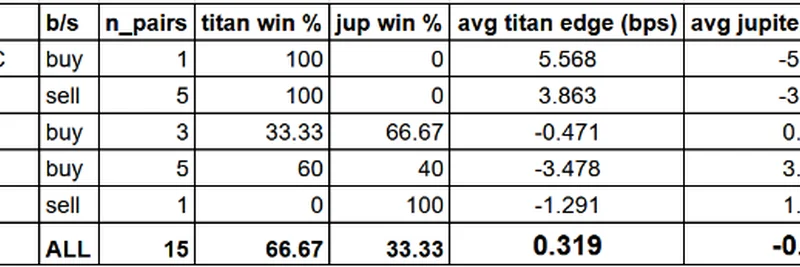Ever feel like the Solana DeFi scene is turning into a full-blown soap opera? This weekend, it sure did. A flurry of threads and hot takes lit up X (formerly Twitter) as traders and builders squared off over which decentralized exchange aggregator reigns supreme: Titan Exchange or the established giant Jupiter Exchange. At the center of the storm? Real-world swap performance—because in crypto, especially when you're flipping meme tokens like $BONK or $WIF, every basis point counts.
If you're new to this, let's break it down simply: DEX aggregators like Titan and Jupiter hunt for the best swap routes across Solana's liquidity pools, aiming to minimize slippage and fees so you get the most bang for your buck. But talk is cheap—data doesn't lie. Enter @diggeronchain, an on-chain vet since 2017, who rolled up their sleeves for a no-holds-barred test.
The Test That Sparked the Fire
Digger executed 80 swaps totaling around $260k in notional value, using sizes like 500 USDC, 2k USDC, 10k USDC (and equivalent SOL amounts). They skipped the hype and focused on executed prices—what actually hit your wallet after the dust settled, not just shiny quotes on a UI. Tools? Default interfaces with Solflare wallet's auto-approve for fairness.
The headline numbers? Titan crushed it:
- Win rate: 80% better executions across all trades.
- Average edge: +1.28 basis points (that's +0.0128%—small, but it adds up on big volumes).
Narrow it to same-block executions (30 trades), and Titan still led with a 66.7% win rate and +0.319 bps edge. Digger noted quirks like Jupiter sometimes landing swaps a slot earlier (delaying Titan by under a second) and a few stalls on Jupiter's end. No one's perfect, but the data leaned Titan.
Check out the visuals from Digger's breakdown:
They even shared a Pastebin of raw trades for the skeptics. Pro tip: If you're trading volatile meme tokens on Solana, where prices swing wilder than a cat on caffeine, these edges could save you serious SOL.
Marius from Kamino Weighs In
Kamino co-founder @y2kappa (a Solana bear market survivor and ex-Bloomberg journo) couldn't resist chiming in. His take? Cut the drama—focus on realized prices, not frontend labels or sub-router egos. He spotlighted Digger's thread as the gold standard: rigorous, large-scale, and unbiased. "The only thing that I care about is where I get the best rate," he posted, calling Titan the winner based on the evidence.
@y2kappa's reply thread drew fire and praise alike. Some hailed the data-driven vibe, while others nitpicked—like calls for manual approvals over auto (to mimic pro traders) or UI gripes (Titan's load times irk casual users). One reply even dropped a fresh benchmark against Binance, crowning DFlow as the ultimate goat for SOL→USDC trades, with Solana DEXs trouncing CEX fees by 5-10 bps on average.
What This Means for Meme Traders and Solana Degens
Look, Solana's meme token ecosystem thrives on speed and low costs—think rapid pumps on platforms like Pump.fun. If Titan's delivering tighter executions more often, it could shift how you route those quick flips. But don't ditch Jupiter yet; it's battle-tested for complex routes and has that slick UI edge.
The real lesson? Test your own swaps. Tools like Solscan let you verify tx signatures and balances post-trade. And as @0xG_Dragon quipped in the replies: "realized price > label talk always. follow the tape."
This spat isn't just noise—it's pushing Solana's DEXs to level up. Titan's momentum might lure more liquidity, benefiting everyone chasing alpha in meme coins or yield farms. Stay tuned; with open-source data dropping soon (shoutout @kiryl_sol), expect more benchmarks to drop.
Got your own swap war stories? Drop 'em in the comments—we're building the ultimate knowledge base here at Meme Insider for all things Solana memes and beyond.
Originally sparked by this X thread from @y2kappa.



